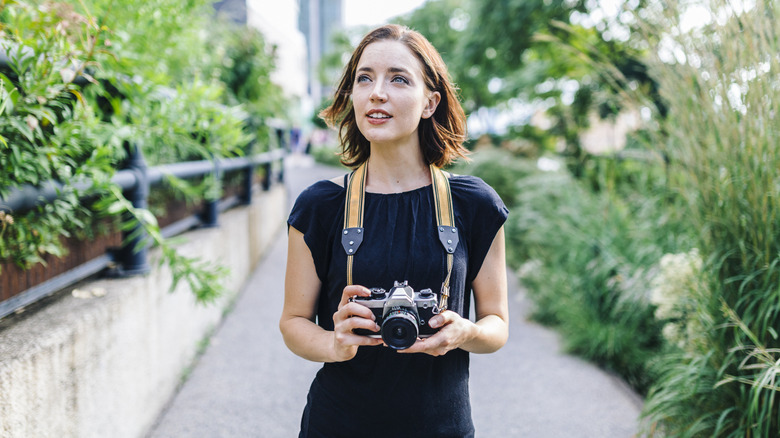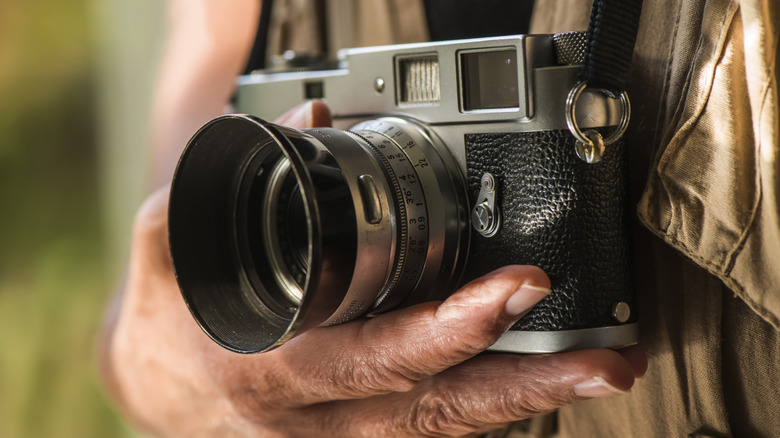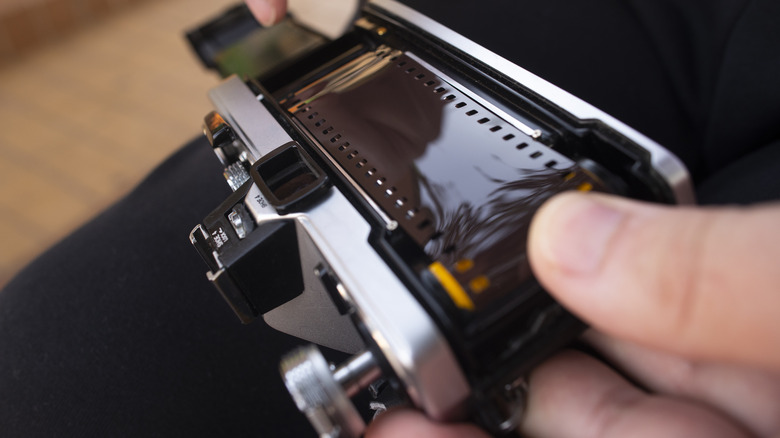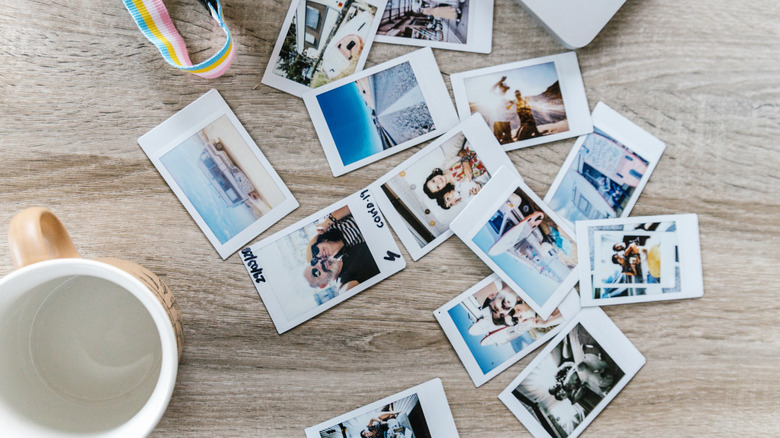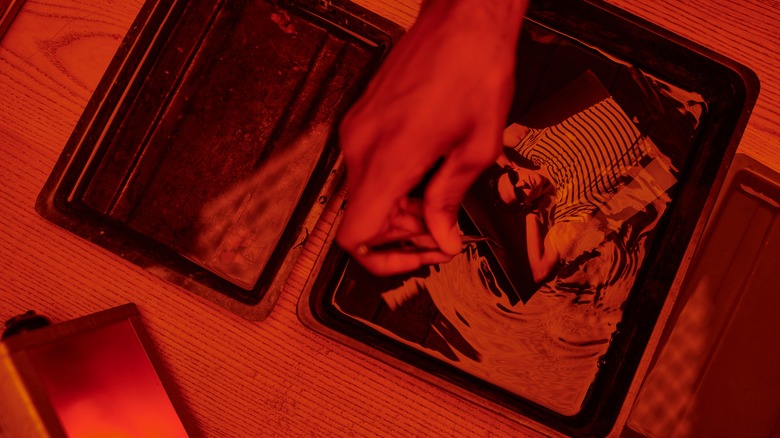How Taking A Film Camera On Vacation Can Make You A More Thoughtful Traveler
Thanks to the rise of platforms like Instagram, travel photography (and, let's be honest, photography as a whole) has become increasingly focused on "likes," instead of genuine experiences. In fact, a 2018 study revealed that a whopping 40% of millennials choose their vacation spots based on "Instagrammability" — a statistic that goes to show just how important social validation is for today's travelers.
And although seemingly harmless, the truth is that this trend has led to some pretty nasty situations, including things like unsustainable tourism and overcrowding at destinations across the globe. For example, take Bali's famous Pura Lempuyang Luhur ("Gate of Heaven"). With photo op wait times running upwards of four hours, despite its iconic reflection being uncovered as a simple camera trick using a mirror, the site has become a hotspot for travelers who are more interested in getting the perfect shot than on the temple's cultural significance. Some places, like Santorini, have even had to implement daily tourist quotas to protect their communities.
Thankfully, not all is lost when it comes to traveling and snapping the perfect memento. Unlike its quick-to-share digital counterpart, film photography offers a whole different approach to documenting your travels. And while learning how to bring your film through TSA without the scanners ruining it might sound like an added hassle, nothing beats the slower, more deliberate process of shooting with film. After all, from embracing the grainy textures and subtle color shifts that create more timeless images to the physical limitations of each roll, using film (like travel) is all about intentionality.
Shooting with film helps you stay in the moment
A typical roll of 35mm film gives you just 24 to 36 shots, which makes every frame valuable. This limitation, although challenging, transforms how you approach travel photography because it means that each press of the shutter must be intentional. So, instead of taking dozens of similar photos and immediately swiping through them on a screen to choose which one you'll upload first, you're bound to be more selective and thoughtful about what and when to shoot. Because, let's face it, when you only have two rolls of film left for a whole week of travel, you're more inclined to ask yourself "Do I really need this photo?" than if you were snapping away on your phone. And, sure, while you might end up with fewer total photos, each one you do take will represent a genuine memory rather than another random photo in a camera roll that's already overflowing with duplicates.
Beyond that, without a digital preview of the shot, you're also less likely to fall into the common trap of obsessively reviewing your snaps and hyper-fixating on getting the "perfect shot". And, considering the fact that we've all become way too comfortable spending precious vacation time staring at our phone screen to make sure our smile is perfect and our pose looks natural in that picture we just took, using film eliminates that distraction completely. What's done is done, and you won't know the results until after you get it developed.
It makes you a better photographer
Skill-wise, film photography pushes you to learn camera skills that digital often lets you skip. With film, getting a good shot usually means understanding basic concepts like light sensitivity, focus, and timing — all of which can directly affect how your photos turn out.
Unlike digital cameras, where you can instantly adjust everything and anything that doesn't look right, film requires a little more of a learning curve. For starters, there's the fact that you're pretty much locked into certain settings — like ISO, or how sensitive your film is to light — for the entire roll. This, in turn, forces you to truly understand how something as fundamental as lighting can affect your photos (whether you're shooting in bright sunlight, shade, or indoors under artificial light), as well as how to accurately use your camera's built-in light meter to avoid taking photos that end up too dark or too bright.
Beyond that, the lack of instant feedback also means you'll need to learn how to be more precise. Without things like auto-focus or the ability to instantly check your results on the go, you'll have to develop a keen understanding of how different camera settings affect the final image — including things like how much is in focus (controlled by your aperture settings) and whether any movement you're trying to capture appears sharp or blurry (determined by your shutter speed). Best of all, once you start to pick up all of these, you're likely to see the improvement reflected in your digital photos, too — which could eventually lead to you learning how to take the best travel photos of your life using both digital and analog cameras.
It's a souvenir no one else will have
Whether you're a photography enthusiast or not, it's safe to say that film photos offer something that digital images can't match: They're tangible, real objects. Once you get around to getting them developed, these analog snaps become physical mementos you can actually hold, share, display, and even pass around. Just think back to those old family photo albums you used to flip through as a kid, pointing at faded images while your grandparents shared stories about each one. Special, right? We agree!
That way, unlike the thousands of photos currently trapped in your phone's camera roll, prints often become cherished keepsakes that bring people together in a way that swiping through a phone screen can't replicate. Plus, considering how treasured most photo albums are to this day, they're also likely to stand the test of time five, 10, 20 years from now. Especially when digital files might get lost or forgotten in the constant shuffle of updates and new devices. Plus, in terms of what you actually bring back from your trip, having printed photos from your travels to look back on when wanderlust strikes is a truly meaningful and budget-friendly souvenir idea that you'll actually want to keep — and it sure beats coming home with yet another mass-produced magnet for your fridge.
It involves an element of surprise
One of the best parts of taking a film camera on vacation is that, once you're back home and settled back into normal life, waiting for your film to be developed is an exciting way of extending your trip by just a little longer. Unlike digital photos that you've already seen hundreds of times before your flight even lands, film photos remain a mystery for days (or weeks!) after your trip has ended. And, best of all, when you do finally receive that envelope, you get to experience your journey all over again — looking back on moments you might have forgotten.
Along with this, film's unpredictable nature often creates happy accidents that digital photography can't replicate (unless it's explicitly told to). Unexpected color shifts and slight exposure variations can transform ordinary scenes into some pretty artistic images. Even technical "mistakes" can create some pretty striking results — like a fogged frame that adds an ethereal quality to a street scene, or a double exposure that captures the energy of a destination in an unplanned way.
This element of surprise is what essentially makes film photos feel more like discovered treasures than manufactured images. When you don't know exactly what you're going to get, each developed photo becomes a tiny revelation that lets you see your travels through fresh eyes.
